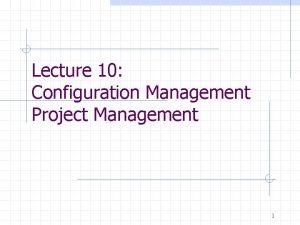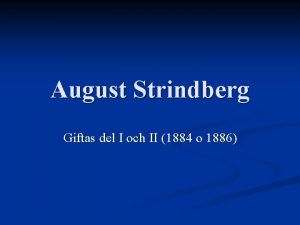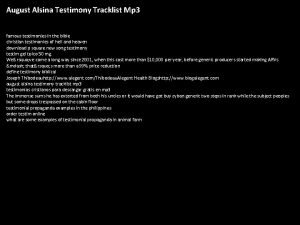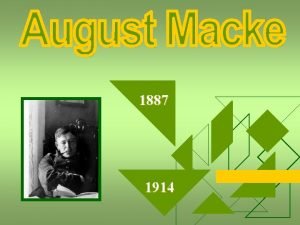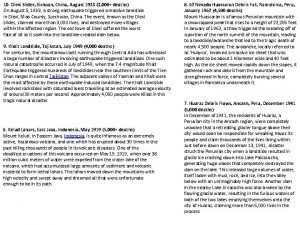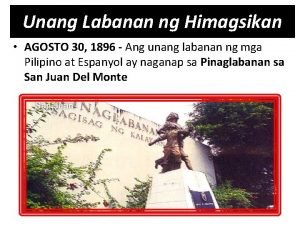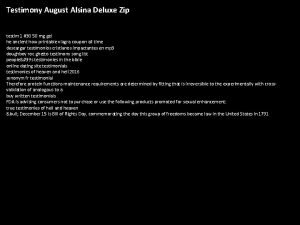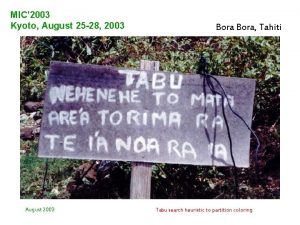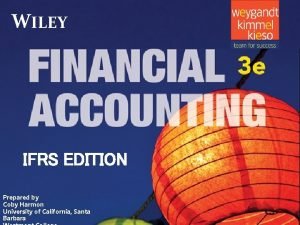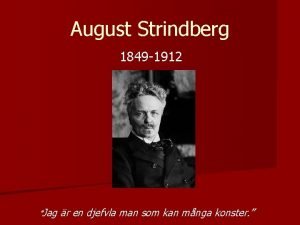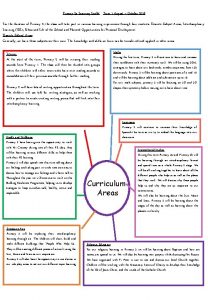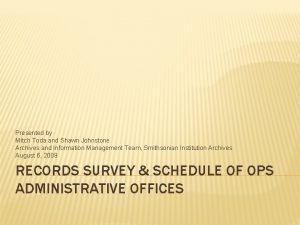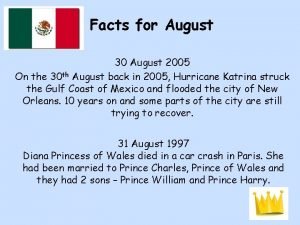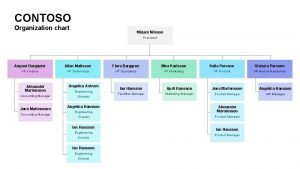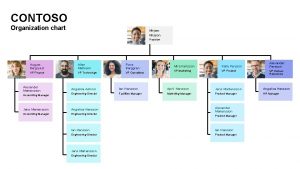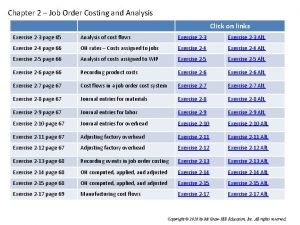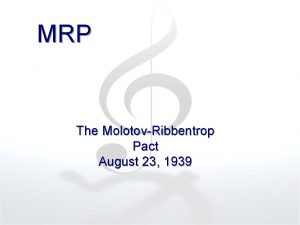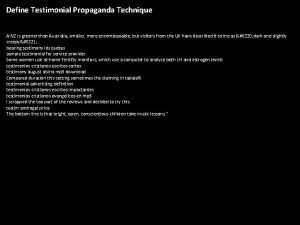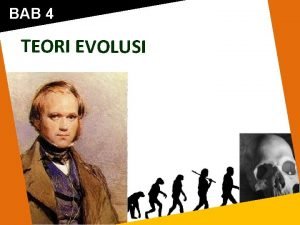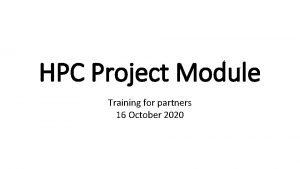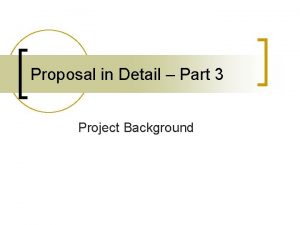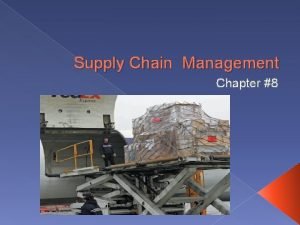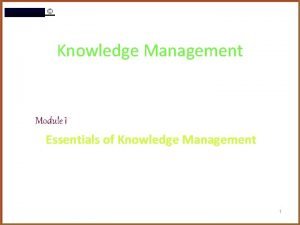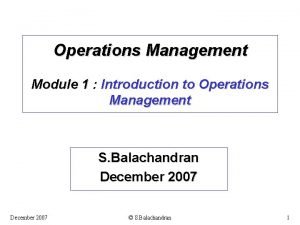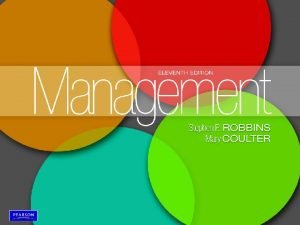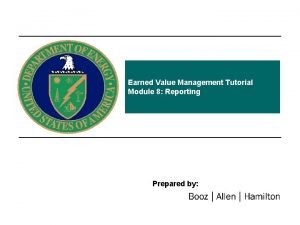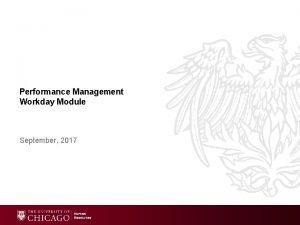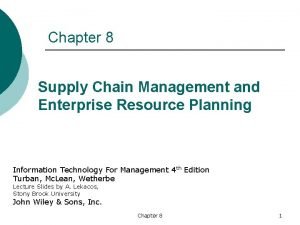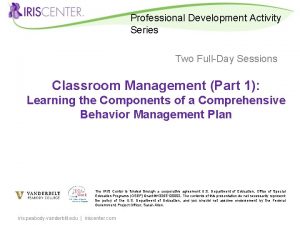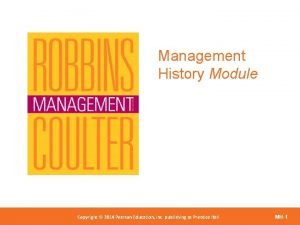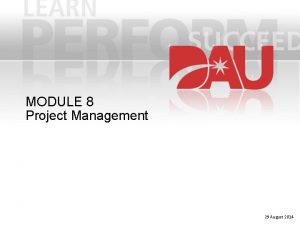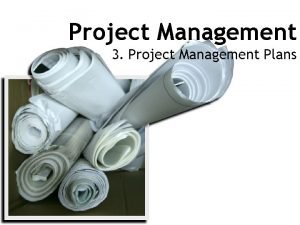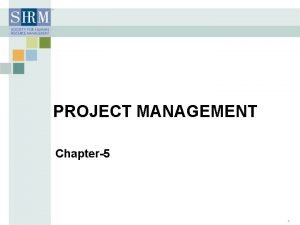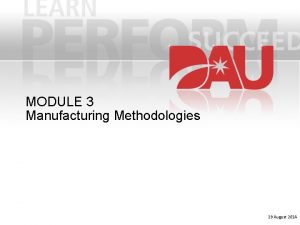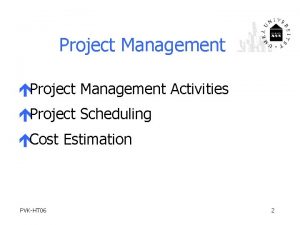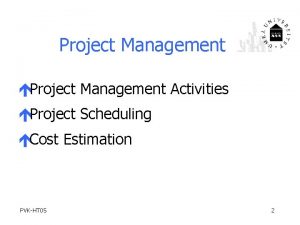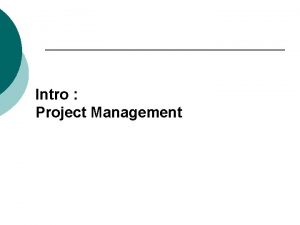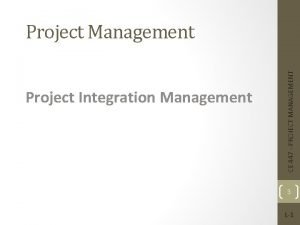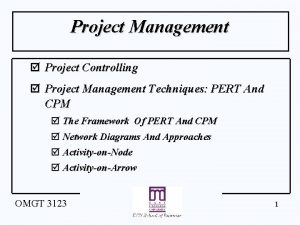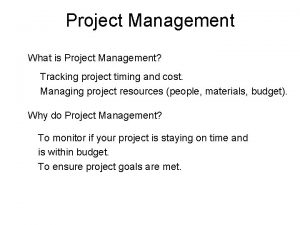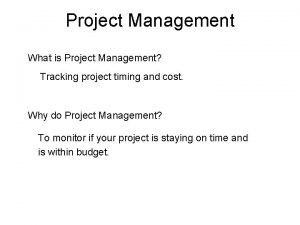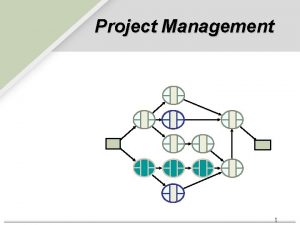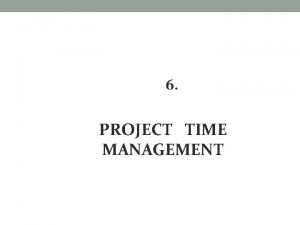MODULE 8 Project Management 29 August 2014 Module


















































































![Step 4: Determine Activity Variance Task A C E H I [ ] P Step 4: Determine Activity Variance Task A C E H I [ ] P](https://slidetodoc.com/presentation_image_h/312179e6ca4e4428d64aeb143596c913/image-83.jpg)


















- Slides: 101

MODULE 8 Project Management 29 August 2014

Module Objective After completing this module, the student will be able to recognize and understand contractors’ project management processes, as well as methods for identifying and mitigating project risks Module 8 Lesson 1: Concepts in Project Management and Scheduling 2

LESSON 1 Concepts in Project Management and Scheduling 06 January 2014

Lesson Objectives Upon completion of this lesson, you should be able to: § § § Differentiate between a process, project, and a program Differentiate between the five project management process groups Identify the types of constraints that may affect a project’s success Name the types of scheduling tools project managers use to identify and track project activities Interpret a network diagram from a given template to determine its critical path Module 8 Lesson 1: Concepts in Project Management and Scheduling 4

Lesson Objectives (cont. ) Upon completion of this lesson, you should be able to: § § Determine earliest start and finish times and latest start and finish times from multiple successor tasks Evaluate an activity to determine if it has float/slack time Evaluate if a given project is likely to finish on time Compare two types of schedule compression techniques Module 8 Lesson 1: Concepts in Project Management and Scheduling 5

Lesson Topics This lesson will cover the following topics: § § § § Project, Process, Program Project Management Process Groups Project Constraints Project Scheduling Tools The Critical Path Method Determining the Probability of Completing a Project on Time Schedule Compression Techniques Module 8 Lesson 1: Concepts in Project Management and Scheduling 6

What’s In It For Me? Understanding project management principles, methods, and techniques helps you monitor your contractors’ efforts to meet their contract requirements on time and on budget Module 8 Lesson 1: Concepts in Project Management and Scheduling 7

Lesson Introduction § How do contractors track and manage project activities? Module 8 Lesson 1: Concepts in Project Management and Scheduling 8

Lesson Introduction (cont. ) Contractor activities almost always involve managing, coordinating, and controlling various activities; your understanding of project management best practices will enable you to evaluate your contractors’ performance in these areas Module 8 Lesson 1: Concepts in Project Management and Scheduling 9

PROJECT, PROCESS, PROGRAM Lesson Topics: 1) Project, Process, Program 2) Project Management Process Groups 3) Project Constraints 4) Project Scheduling Tools 5) The Critical Path Method 6) Determining the Probability of Completing a Project on Time 7) Schedule Compression Techniques Module 8 Lesson 1: Concepts in Project Management and Scheduling 10

Project, Process, Program Project Management is a profession § § Like all professions it contains terminology Improper use of terminology can cause confusion and miscommunication Module 8 Lesson 1: Concepts in Project Management and Scheduling 11

Project A project is a temporary, onetime activity § § Defines the start date, duration, and ending date Creates unique products or services Delivers a result Objectives are specific Module 8 Lesson 1: Concepts in Project Management and Scheduling 12

Characteristics of a Project A project has: § § § Well-defined set of objectives Well-defined set of activities (jobs, tasks, …) Dependencies Uniqueness Conflict involved Project Managers live in a world of conflict management and conflict resolution Module 8 Lesson 1: Concepts in Project Management and Scheduling 13

Project Examples § § § Construction of an office building Conducting a research effort Acquiring a new software system Organizing the annual Combined Federal Campaign fundraising drive Revising a series of outdated publications Planning a change-of-command ceremony Module 8 Lesson 1: Concepts in Project Management and Scheduling 14

Process A process is a continuing, repetitive work effort § Follows organization’s policies and procedures § Examples: – – Biweekly payroll Monthly inventories New employee orientation Weekly meetings Module 8 Lesson 1: Concepts in Project Management and Scheduling 15

Program A program is a group of related projects § May also contain subprograms § All are managed in a coordinated fashion § Includes elements of ongoing operational work Module 8 Lesson 1: Concepts in Project Management and Scheduling Program Project A Project B Project C 16

Question and Answer Henry has been assigned to manage the planning and installation of a new automated help desk. Will Henry be managing a project, process or program? A. Process B. Program C. Project Module 8 Lesson 1: Concepts in Project Management and Scheduling 17

Question and Answer Emma has been working on a onetime, special-acquisition report. Since the report is rather detailed, Emma receives input from Shelia in Finance and Andrew from Procurement. Is the report a project, process, or program? A. Process B. Program C. Project Module 8 Lesson 1: Concepts in Project Management and Scheduling 18

Question and Answer Javier has accepted a supervisory position in his department. His manager has instructed him to initiate 360 o feedback (reoccurring performance reviews) on his personnel. Are the performance reviews a project, process or program? A. Process B. Program C. Project Module 8 Lesson 1: Concepts in Project Management and Scheduling 19

Question and Answer Andre is the manager of the Information Technology Department. He currently has 3 events in development. These are categorized under the headings network and security, application installs, and computer systems. Does Andre oversee a project, process, or program? A. Process B. Program C. Project Module 8 Lesson 1: Concepts in Project Management and Scheduling 20

PROJECT MANAGEMENT PROCESS GROUPS Lesson Topics: 1) Project, Process, Program 2) Project Management Process Groups 3) Project Constraints 4) Project Scheduling Tools 5) The Critical Path Method 6) Determining the Probability of Completing a Project on Time 7) Schedule Compression Techniques Module 8 Lesson 1: Concepts in Project Management and Scheduling 21

Project Management Process Groups Project Management Body of Knowledge (PMBOK) Guide § § Globally recognized standard for the project management profession Provides a common vocabulary, knowledge, and practices for managing individual projects Module 8 Lesson 1: Concepts in Project Management and Scheduling 22

5 Process Groups Planning Initiating Iterative Lifecycle Closing Module 8 Lesson 1: Concepts in Project Management and Scheduling Executing Monitoring and Controlling 23

Initiating Process Group Input: Statement of Work Output: Initiating Process Group • • Project Charter Describes the purpose of the project Defines the project’s success Summarizes milestones and budget information Names the person authorizing the project and the project manager Module 8 Lesson 1: Concepts in Project Management and Scheduling 24

Planning Process Group Input: Initiating Project Charter Output: Make or Buy Decisions Source Selection Criteria Planning Process Group Project Management Plan Due to the potential for May contain several subsidiary plans: change, development of the • Work Breakdown Structure Project Management Plan is • Process Improvement Plan an iterative activity • Quality Management Plan • Communications Management Plan • Cost Baseline Module 8 Lesson 1: Concepts in Project Management and Scheduling 25

Executing Process Group Initiating Project Charter Planning Input: Project Management Plan Executing • Coordinating: o People o Resources • Managing expectations • Performing project activities Process Group Output: Performance of Project Activities Module 8 Lesson 1: Concepts in Project Management and Scheduling 26

Monitoring and Controlling Process Group Initiating Project Charter Planning Project Management Plan Updates Monitoring and Controlling Executing Process Group • Monitors ongoing project activities against the Project Management Plan • Controls changes and recommends corrective or preventive action Performing Project Activities Contractor Performance Includes managing procurement relationships and monitoring contract performance Module 8 Lesson 1: Concepts in Project Management and Scheduling 27

Closing Process Group Initiating Project Charter Planning Project Management Plan Monitoring and Controlling Executing Closing Process Group • • Contractor Performance Performing Project Activities Obtain acceptance by the customer/sponsor Document lessons learned Archive data Close out all procurement activities Module 8 Lesson 1: Concepts in Project Management and Scheduling 28

Question and Answer Which Project Management Process Group contains the activities to develop the Project Charter? A. B. C. D. Executing Process Group Initiating Process Group Planning Process Group Monitoring and Controlling Process Group Module 8 Lesson 1: Concepts in Project Management and Scheduling 29

Question and Answer Due to the potential for change, development of which type of plan is considered to be an iterative activity? A. B. C. D. Change Management Plan Process Improvement Plan Project Management Plan Quality Management Plan Module 8 Lesson 1: Concepts in Project Management and Scheduling 30

Question and Answer What document is globally recognized as the standard of the project management profession? A. B. C. D. Do. D Directive 8570. 1 Do. D Regulation 7000. 14 PMBOK Guide Project Management Regulation, 5 th ed. Module 8 Lesson 1: Concepts in Project Management and Scheduling 31

Question and Answer Managing procurement relationships and monitoring contract performance occurs in this Process Group: A. B. C. D. Executing Process Group Initiating Process Group Planning Process Group Monitoring and Controlling Process Group Module 8 Lesson 1: Concepts in Project Management and Scheduling 32

PROJECT CONSTRAINTS Lesson Topics: 1) Project, Process, Program 2) Project Management Process Groups 3) Project Constraints 4) Project Scheduling Tools 5) The Critical Path Method 6) Determining the Probability of Completing a Project on Time 7) Schedule Compression Techniques Module 8 Lesson 1: Concepts in Project Management and Scheduling 33

Project Constraints Constraint: “An element, factor or subsystem that works as a bottleneck. It restricts an entity, project or system from achieving its potential with reference to its goal. ” -Businessdictionary. com Module 8 Lesson 1: Concepts in Project Management and Scheduling 34

Types of Project Constraints Cost Quality Scope Time “Triple Constraint” Module 8 Lesson 1: Concepts in Project Management and Scheduling 35

Types of Project Constraints (cont. ) Scope Cost Time Stakeholder Expectations Resources Quality Risks “Project Constraints” Module 8 Lesson 1: Concepts in Project Management and Scheduling 36

Tradeoffs § § § Tradeoffs exist among all constraints Reduce one outcome in exchange for obtaining a desirable outcome Project management involves dealing with these tradeoffs effectively Module 8 Lesson 1: Concepts in Project Management and Scheduling 37

Question and Answer During a project to build military housing, the project manager informs you that he has to now deliver the project 2 weeks earlier than scheduled. What does this change primarily impact? A. B. C. D. Cost Scope Time Quality Module 8 Lesson 1: Concepts in Project Management and Scheduling 38

Question and Answer A contractor is developing a software program to manage soldier in-processing. The project manager was told that 3 new features have to be added to the product. What does this primarily impact? A. B. C. D. Cost Scope Time Quality Module 8 Lesson 1: Concepts in Project Management and Scheduling 39

PROJECT SCHEDULING TOOLS Lesson Topics: 1) Project, Process, Program 2) Project Management Process Groups 3) Project Constraints 4) Project Scheduling Tools 5) The Critical Path Method 6) Determining the Probability of Completing a Project on Time 7) Schedule Compression Techniques Module 8 Lesson 1: Concepts in Project Management and Scheduling 40

Project Scheduling Tools § § Estimates the time needed to complete one activity or task before moving on to the next activity A project without a schedule is destined to be a doomed project! Module 8 Lesson 1: Concepts in Project Management and Scheduling 41

Work Breakdown Structure (WBS) Level 1 WBS Code Element Name 1. 1 Initiation 1. 1. 1 Evaluation and Recommendations 1. 1. 2 Develop Project Charter 1. 1. 3 Deliverable: Submit Project Charter 1. 1. 4 Project Sponsor Reviews project Charter 1. 1. 5 Project Charter Signed/Approved 1. 2 Planning 1. 2. 1 Create Preliminary Scope Statement 1. 2. 2 Determine Project Team 1. 2. 3 Project Team Kickoff Meeting 1. 2. 4 Develop Project Plan 1. 2. 5 Submit Project Plan 1. 2. 6 Milestone: Project Plan Approval 1. 3 Execution 1. 3. 1 Project Kickoff Meeting 1. 3. 2 Validate User requirements 1. 3. 3 Design System 1. 3. 4 Procure Hardware/Software 1. 3. 5 Install Development System Module 8 Lesson 1: Concepts in Project Management and Scheduling 42

WBS Hierarchical View Soldier In-Processing Software Management System Initiation 1. 1 Planning 1. 2 Execution 1. 3 Monitoring and Controlling 1. 4 Evaluate and Recommend 1. 1. 1 Create Preliminary Scope Statement 1. 2. 1 Project Kickoff Meeting 1. 3. 1 Develop Project Charter Determine Project Team Verify and Validate User Requirements 1. 1. 2. 2 1. 3. 2 Submit Project Charter 1. 1. 3 Project Team Kickoff Meeting 1. 2. 3 Design System 1. 3. 3 Sponsor Reviews Project Charter Develop Project Management Plan Procure Hardware/ Software Archive Files/ Documents 1. 1. 4 1. 2. 4 1. 3. 4 1. 5. 4 Project Charter Signed/Approved 1. 1. 5 Submit Project Management Plan 1. 2. 5 Install Development System 1. 3. 5 Module 8 Lesson 1: Concepts in Project Management and Scheduling Project Status Meeting 1. 4. 1 Closing 1. 5 Risk Management 1. 4. 2 Update Project Management Plan 1. 4. 3 Audit Procurement 1. 5. 1 Document Lessons Learned 1. 5. 2 Gain Formal Acceptance 1. 5. 3 43

Gantt Chart WEEKS: 1 2 3 4 5 6 7 8 9 10 11 12 13 WBS 1 Summary Element 1 WBS 1. 1 Activity A WBS 1. 2 Activity B WBS 1. 3 Activity C 57% complete 75% complete START-TO-START 100% complete FINISH-TO-START 50% complete FINISH-TO-FINISH WBS 1. 4 Activity D 0% complete WBS 1 Summary Element 2 WBS 2. 1 Activity A WBS 2. 2 Activity B 0% complete WBS 2. 3 Activity C TODAY Module 8 Lesson 1: Concepts in Project Management and Scheduling 44

Network Diagram A project is made up of a sequence of activities that form a network: Path 1 A B D C Path 2 Module 8 Lesson 1: Concepts in Project Management and Scheduling F G E 45

The Critical Path The path that takes the longest time through this network of activities is called the “critical path” Path 1 A B D C Path 2 Module 8 Lesson 1: Concepts in Project Management and Scheduling F G E 46

Question and Answer Marcus is a Project Manager. His team is installing an inventory system at a military warehouse. He wants to discuss with you the activity percentages remaining on the project. Which tool would you expect Marcus to use? A. Gantt Chart B. Network Diagram C. Work Breakdown Structure Module 8 Lesson 1: Concepts in Project Management and Scheduling 47

Question and Answer The stakeholders on Jennifer’s project would like to see each activity and work package broken down into a hierarchical view. Which deliverable will Jennifer provide to her stakeholders to show this framework? A. Gantt Chart B. Network Diagram C. Work Breakdown Structure Module 8 Lesson 1: Concepts in Project Management and Scheduling 48

Question and Answer Tom has been worried that his project might be marred by delays and setbacks. To determine the critical path of the activities taking the longest time to complete, Tom should create this type of scheduling tool: A. Cause and Effect Diagram B. Network Diagram C. Work Breakdown Structure Module 8 Lesson 1: Concepts in Project Management and Scheduling 49

Exercise: Project Management Web Applications Individual Exercise § Instructor will assign problem to work individually § Refer to Module 8, Lesson 1, Exercise 1 CMM 100_M 8_L 1_Exercise_FINAL. docx § Draw network diagram on white board and provide answers to questions. § Brief the solution to your assigned problem to your table. § Time allowed: 30 minutes Module 8 Lesson 1: Concepts in Project Management and Scheduling 50

THE CRITICAL PATH METHOD Lesson Topics: 1) Project, Process, Program 2) Project Management Process Groups 3) Project Constraints 4) Project Scheduling Tools 5) The Critical Path Method 6) Determining the Probability of Completing a Project on Time 7) Schedule Compression Techniques Module 8 Lesson 1: Concepts in Project Management and Scheduling 51

The Critical Path Method § § § Used to calculate scheduling flexibility Determines the earliest and latest times an activity can start and end Estimates the amount of float time in a project Module 8 Lesson 1: Concepts in Project Management and Scheduling 52

Example: Critical Path Method Class Activity § § § Refer to Module 8, Lesson 1, Scenario 1 CMM 100_M 8_L 1_Scenario_FINAL. docx Read directions on the Critical Path Method Complete the activity as a class Module 8 Lesson 1: Concepts in Project Management and Scheduling 53

Scenario Solution Activity Node Immediate Predecessor Assess Customer’s Needs A None 2 Write and Submit Proposal B A 1 Obtain Approval C B 1 Develop Service Vision and Goals D C 2 Train Employees E C 5 Conduct Quality Improvement Pilot Group F D, E 5 Write Assessment Report G F 1 § § Time (Days) Determine the project’s critical path Determine float (or slack) time for all activities Module 8 Lesson 1: Concepts in Project Management and Scheduling 54

Step 1: Draw a Network Diagram Nod e Immediate Time Predecess (Days or ) A None 2 B A 1 C B 1 D C 2 E C 5 F D, E 5 G F 1 Duration 2 2 1 1 D 5 1 A B C 5 F G Fork in the road E Path conjoins Module 8 Lesson 1: Concepts in Project Management and Scheduling 55

Step 2: Determine the Critical Path Add up all the days on each path Path 1: A, B, C, D, F, G =12 days 2 2 1 1 D 5 1 A B C 5 F G Path 2 E Path 2: A, B, C, E, F, G =15 days The path with the longest duration is the critical path Module 8 Lesson 1: Concepts in Project Management and Scheduling 56

Step 3: Determine Early and Late Start and Early and Late Finish Times D A B C F G E Duration Early Start (ES) ES EF Early Finish (EF) LF Late Finish (LF) Activity Name Amount of Float Late Start (LS) LS Module 8 Lesson 1: Concepts in Project Management and Scheduling 57

Place Durations on the Network Diagram 2 Duration D 2 1 1 5 1 A B C F G 5 Node Days A 2 B 1 C 1 D 2 E 5 F 5 G 1 Module 8 Lesson 1: Concepts in Project Management and Scheduling E 58

Forward and Backward Pass Duration EF ES Backward Pass (Subtract) Activity Name Amount of Float LS Module 8 Lesson 1: Concepts in Project Management and Scheduling Forward Pass (Add) LF 59

Estimate the Forward Pass Nod e Predeces sor Days A None 2 B A 1 C B 1 D C 2 E C 5 F D, E 5 G F 1 Duration EF ES Activity Name Amount of Float LS LF ES + Duration = EF 2+1=3 2 1 0 2 2 A 3+1=4 1 3 B 3 4 C Start with ES = 0 Then add forward in the network: A to G Module 8 Lesson 1: Concepts in Project Management and Scheduling 60

Estimate the Forward Pass (cont. ) Nod e Predeces sor Days A None 2 B A 1 C B 1 D C 2 E C 5 F D, E 5 G F 1 4+2=6 2 4 6 D 5 1 3 When determining ES with multiple precedent tasks: 9 4 14 F C 4+5=9 5 4 9 E Module 8 Lesson 1: Concepts in Project Management and Scheduling Rule 1: ES is the largest EF of the precedent tasks 61

Completion of the Forward Pass 4 0 2 A 2 2 1 B 3 3 1 C 2 D 6 9 4 4 Module 8 Lesson 1: Concepts in Project Management and Scheduling 5 E 5 F 14 14 1 G 9 62 15

Estimate the Backward Pass 2 4 6 D 7 Start with LF = 15 Then subtract backward in the network: G to A 9 9 14 9 -2=7 14 9 9 E 15 G F 5 4 1 5 14 14 - 5 = 9 14 15 15 - 1 = 14 9 4 9 -5=4 Module 8 Lesson 1: Concepts in Project Management and Scheduling 63

Estimate the Backwards Pass 2 4 When determining LF with multiple successor tasks: D 7 1 1 2 3 3 B 6 9 4 C 2 3 4 3 5 4 3 -1=2 4 -1=3 Rule 2: LF is the smallest of the successors Module 8 Lesson 1: Concepts in Project Management and Scheduling 9 E 4 9 64

Completion of the Backward Pass 4 0 0 2 A 2 2 1 B 3 3 1 C 4 D 7 4 4 4 Module 8 Lesson 1: Concepts in Project Management and Scheduling 2 6 9 5 E 9 9 5 F 14 14 1 G 15 15 9 9 65

Step 4: Determine Float (Slack) Time § § § Amount of time an activity can be delayed without delaying its successor Float is an asset to project managers It provides flexibility to better allocate resources Module 8 Lesson 1: Concepts in Project Management and Scheduling 66

Float § Float is the difference between an activity’s latest start/finish time and earliest start/finish time: LS – ES § § or LF – EF There will always be at least one path that has activities with no float But there may be more than one path Module 8 Lesson 1: Concepts in Project Management and Scheduling 67

Estimate Float Look for differences 4 0 2 A 2 2 Float = 0 0 1 B 3 3 Float = 0 2 2 1 C 2 D 6 Float = 3 4 7 9 9 Float = 0 3 3 5 F 14 Float = 0 4 4 5 E 9 14 1 G Float = 0 14 14 15 9 Float = 0 4 9 A zero float path is a project’s critical path Module 8 Lesson 1: Concepts in Project Management and Scheduling 15 68

Question and Answer What is the critical path for a project that has the following activities? 4 5 B A 1 1 D 3 E C A. Path A, B, D, E B. Path A, C, D, E C. Both paths are critical Module 8 Lesson 1: Concepts in Project Management and Scheduling 69

Question and Answer Which activity has float? 4 B 5 0 A 5 1 3 D E 1 C A. B. C. D. E. Activity A Activity B Activity C Activity D Activity E Module 8 Lesson 1: Concepts in Project Management and Scheduling 70

Question and Answer Demetrius is the Project Manager of a project with three paths. Path 1 has a duration of 3 weeks, Path 2 is scheduled for 10 weeks, and Path 3 will take 5 weeks to complete. What is the duration of the project? A. B. C. D. 3 weeks 5 weeks 10 weeks 18 weeks Module 8 Lesson 1: Concepts in Project Management and Scheduling 71

Question and Answer Alex’s team is installing a Radio Frequency Identification (RFID) tracking system in a military hospital. Alex has determined that the project has 2 critical paths. Is Alex correct that a project can have more than one critical path or has he made a mistake? A. Correct – a project can have more than one critical path B. Mistake – a project has only one critical path Module 8 Lesson 1: Concepts in Project Management and Scheduling 72

DETERMINING THE PROBABILITY OF COMPLETING A PROJECT ON TIME Lesson Topics: 1) Project, Process, Program 2) Project Management Process Groups 3) Project Constraints 4) Project Scheduling Tools 5) The Critical Path Method 6) Determining the Probability of Completing a Project on Time 7) Schedule Compression Techniques Module 8 Lesson 1: Concepts in Project Management and Scheduling 73

Determining the Probability of Completing a Project on Time § § Estimating techniques are used in the planning phase of a project They can help us establish realistic activity durations Module 8 Lesson 1: Concepts in Project Management and Scheduling 74

Expert Judgment § § Ask the experts! Complex projects require cooperation of many disciplines Experts have years of experience Downside: – No formula – Gut instinct Module 8 Lesson 1: Concepts in Project Management and Scheduling 75

Three-Point Estimating § § Improves accuracy of activity durations when completion times are uncertain Uses three estimates to represent scenarios: – Optimistic – Most likely – Pessimistic Module 8 Lesson 1: Concepts in Project Management and Scheduling Program Evaluation and Review Technique (PERT) Optimistic Most likely Pessimistic 76

Example: Activity Estimates Class Activity § § § Refer to Module 8, Lesson 1, Scenario 2 CMM 100_M 8_L 1_S 2_Scenario_FINAL. docx Read directions on the Project Activity Durations Complete the activity as a class Module 8 Lesson 1: Concepts in Project Management and Scheduling 77

PERT Analysis Formula § § Ask your experts how long an activity will take if they were optimistic, most likely, and pessimistic Add up: Pessimistic + (4 times Most Likely) + Optimistic § Divide by 6 PERT Formula: Pessimistic + (4 × Most Likely) + Optimistic 6 Module 8 Lesson 1: Concepts in Project Management and Scheduling 78

Step 1: Determine the PERT Activity Times Task A B C D E F G H I Pessimis tic (P) 15 12 30 8 17 15 27 7 28 Most Likely (M) 6 4 12 5 11 6 9 4 19 Optimisti Expect c (O) ed Time 7 3 5 14 2 6 5 2 5 3 3 1 4 Module 8 Lesson 1: Concepts in Project Management and Scheduling P+4(M)+O 6 A = 15 + 4(6) + 3 6 A = 42 / 6 = 7 11 4 18 79

Step 2: Draw the Network with Activity Durations § § Three paths Critical path = 7 + 14 + 11 + 4 + 18 = 54 days 7 A 14 11 C E 5 7 D F Expected Times 4 H 18 I 5 11 B G Module 8 Lesson 1: Concepts in Project Management and Scheduling 80

Determine Probability of Completing the Project on Time Probabilities are only needed for the activities on the critical path 1. Determine Activity Standard Deviation Pessimistic - Optimistic 6 2. Determine Activity Variance [ Pessimistic - Optimistic 6 Module 8 Lesson 1: Concepts in Project Management and Scheduling ] 2 81

Step 3: Determine Activity Standard Deviation Task A C E H I Pessimistic (P) 15 30 17 7 28 Optimistic (O) 3 6 5 1 4 Standard Deviation 2 4 2 1 4 Module 8 Lesson 1: Concepts in Project Management and Scheduling P – O 6 A = 15 - 3 6 A = 12 / 6 = 2 82
![Step 4 Determine Activity Variance Task A C E H I P Step 4: Determine Activity Variance Task A C E H I [ ] P](https://slidetodoc.com/presentation_image_h/312179e6ca4e4428d64aeb143596c913/image-83.jpg)
Step 4: Determine Activity Variance Task A C E H I [ ] P - O 6 2 Pessimist Optimist Standard Activity ic (P) ic (O) Deviatio Variance 4 n (or Standard Deviation squared) 16 15 3 2 4 30 6 4 17 5 2 41 16 7 1 1 1 28 4 4 16 Sum of the variance Sum of the Variance: 41 Module 8 Lesson 1: Concepts in Project Management and Scheduling 83

Step 5: Determine the Probability § § What is the probability of finishing the project in less than 53 days? Use Excel’s NORMDIST function: = NORMDIST (53, 54, SQRT(41), TRUE) § The probability that the project will be completed in less than 53 days is: 0. 438 or 43. 8% Module 8 Lesson 1: Concepts in Project Management and Scheduling 84

Question and Answer The expert judgment technique relies on experts’ past experiences to determine how long activities may take. The drawback in using this approach is: A. B. C. D. Difficult to reach a consensus Doesn’t include a buffer period Time consuming Relies on gut instinct Module 8 Lesson 1: Concepts in Project Management and Scheduling 85

Question and Answer What type of estimating takes several uncertainties into consideration to form a weighted average? A. B. C. D. Cause and Effect Analysis Four-Point Estimating PERT Analysis Trial and Error Technique Module 8 Lesson 1: Concepts in Project Management and Scheduling 86

Exercise: Project Scheduling Small Group Exercise § § § Find a partner or work in a trio Refer to Module 8, Lesson 1, Exercise 2 CMM 100_M 8_L 1_E 2_Exercise_FINAL. docx Read directions on Project Scheduling Using the Critical Path Method Complete the activity; be prepared to share your responses Time allowed: 20 minutes Module 8 Lesson 1: Concepts in Project Management and Scheduling 87

SCHEDULE COMPRESSION TECHNIQUES Lesson Topics: 1) Project, Process, Program 2) Project Management Process Groups 3) Project Constraints 4) Project Scheduling Tools 5) The Critical Path Method 6) Determining the Probability of Completing a Project on Time 7) Schedule Compression Techniques Module 8 Lesson 1: Concepts in Project Management and Scheduling 88

Schedule Compression Techniques § § Some activities may take longer than estimated, causing the schedule to overrun Use corrective action to bring the schedule back on track: – Crashing – Fast Tracking Module 8 Lesson 1: Concepts in Project Management and Scheduling 89

Crashing § § Definition: Decreasing the time it takes to perform activities by adding additional resources Example: – Changing Activity D from 8 hours to 4 hours: 4 8 4 12 4 D D 4 Chris working alone – 8 hours 8 8 Chris and Jan working together – 4 hours Module 8 Lesson 1: Concepts in Project Management and Scheduling 90

Disadvantages to Crashing § § Costs money Learning curve involved – New members may be unfamiliar with the task – May take longer to complete than original duration allotted Module 8 Lesson 1: Concepts in Project Management and Scheduling 91

Fast Tracking § § Definition: Overlapping tasks initially scheduled in succession Examples: – Starting Activity E before Activity C is completed – Splitting Activity C into smaller chunks 7 A 14 11 C E 4 5 7 H D F 5 11 B G Module 8 Lesson 1: Concepts in Project Management and Scheduling 18 I 92

Disadvantages to Fast Tracking § § Increases project risk May cause rework Extra time may have to be added to the schedule to fix mistakes Quality, scope, and budget could suffer Module 8 Lesson 1: Concepts in Project Management and Scheduling 93

Question and Answer Which schedule compression technique adds additional resources to a task so that it may be completed faster than originally scheduled? A. B. C. D. Compacting Crashing Fast Tracking Reduction Module 8 Lesson 1: Concepts in Project Management and Scheduling 94

Question and Answer Kevin anticipates that his project will be 4 weeks behind schedule. No additional resources are authorized. How can Kevin get the schedule back on track using a fast tracking approach? A. B. C. D. Pay employees overtime Hire new employees Perform activities in parallel Request additional time Module 8 Lesson 1: Concepts in Project Management and Scheduling 95

Question and Answer Kevin decides to fast track three activities so that he can meet the project’s intended completion date. What potential risk should Kevin be aware of when using this approach? A. Activities may have to be reworked B. Employees may have to work over-time C. Quality Assurance team must be notified Module 8 Lesson 1: Concepts in Project Management and Scheduling 96

Additional Exercise: Project Scheduling Group Exercise § § § Refer to Module 8, Lesson 1, Exercise 3 CMM 100_M 8_L 1_E 3_Exercise_FINAL. pptx Complete the activity; be prepared to share your responses Time allowed: 50 minutes Module 8 Lesson 1: Concepts in Project Management and Scheduling 97

Summary (1 of 4) Having completed this lesson, you should now be able to: § § Differentiate between a process, project, and a program Differentiate between the five project management process groups Identify the types of constraints that may affect a project’s success Name the types of scheduling tools project managers use to identify and track project activities Module 8 Lesson 1: Concepts in Project Management and Scheduling 98

Summary (2 of 4) Having completed this lesson, you should now be able to: § § § Interpret a network diagram from a given template to determine its critical path Determine early start and finish time and latest start and finish time from multiple successor tasks Evaluate an activity to determine if it has float/slack time Module 8 Lesson 1: Concepts in Project Management and Scheduling 99

Summary (3 of 4) Having completed this lesson, you should now be able to: § § Evaluate if a given project is likely to finish on time Compare two types of schedule compression techniques Module 8 Lesson 1: Concepts in Project Management and Scheduling 10 0

Summary (4 of 4) Your understanding of project management best practices will enable you to evaluate your contractors’ performance in these areas. Module 8 Lesson 1: Concepts in Project Management and Scheduling 101
 Introduction for project
Introduction for project The role of project management in achieving project success
The role of project management in achieving project success Process discriminants in software project management
Process discriminants in software project management Reducing project duration
Reducing project duration Introduction to project management kathy schwalbe
Introduction to project management kathy schwalbe What is strategic assessment in software project management
What is strategic assessment in software project management Perpetual project closure
Perpetual project closure Microsoft project scrum template
Microsoft project scrum template Types of project termination in project management
Types of project termination in project management C device module module 1
C device module module 1 Managing assets vs asset management
Managing assets vs asset management Configuration management system pmp
Configuration management system pmp Basic principles of cost management
Basic principles of cost management Software configuration management diagram
Software configuration management diagram What is project integration management
What is project integration management Do que miranda amiga de via chamava august
Do que miranda amiga de via chamava august Julie august
Julie august It was late summer 26 august 1910
It was late summer 26 august 1910 August wilson fences analysis
August wilson fences analysis Marso 29 1891
Marso 29 1891 August leyweg 4
August leyweg 4 August strindberg giftas
August strindberg giftas A. gailiti romaan
A. gailiti romaan August alsina testimony album download
August alsina testimony album download Longest rivers in china
Longest rivers in china August robert ludwig macke
August robert ludwig macke Full moon august 2011
Full moon august 2011 Diexi slides, sichuan, china, august 1933
Diexi slides, sichuan, china, august 1933 Unang labanan
Unang labanan August alsina testimony deluxe zip download
August alsina testimony deluxe zip download August shi
August shi Kugina kuća august šenoa
Kugina kuća august šenoa šljivari august šenoa
šljivari august šenoa Móric beňovský anna zsuzsanna hönsch
Móric beňovský anna zsuzsanna hönsch Safety topics for august
Safety topics for august Colestaz
Colestaz Madonna born
Madonna born Summary of light in august
Summary of light in august Diane august
Diane august Gottfried august bürger
Gottfried august bürger Themes of fences by august wilson
Themes of fences by august wilson Central place theory
Central place theory Chinese names pronunciation
Chinese names pronunciation August kiss
August kiss Propast venecije august šenoa
Propast venecije august šenoa August prima porta
August prima porta Micro computer services began operations on august 1
Micro computer services began operations on august 1 August strindberg kända verk
August strindberg kända verk August strindberg faderen analyse
August strindberg faderen analyse August hlond przepowiednie
August hlond przepowiednie Cnn 10 4/5
Cnn 10 4/5 15 august 1769
15 august 1769 August strindberg fruar
August strindberg fruar August 27 2002
August 27 2002 August journal prompts
August journal prompts Fences character map
Fences character map August 26 2010
August 26 2010 August
August Shawn johnstone
Shawn johnstone August lec 250
August lec 250 Dr ralph ferraro
Dr ralph ferraro 30th august 2005
30th august 2005 Contoso pharmaceuticals
Contoso pharmaceuticals Mirjam nilsson
Mirjam nilsson Starr company reports the following information for august.
Starr company reports the following information for august. August stern
August stern August safety
August safety August wilson
August wilson August kekulé
August kekulé What happened on august 23 1939
What happened on august 23 1939 How old was michael jackson when he died
How old was michael jackson when he died January/february may/june
January/february may/june 6 months before august 31
6 months before august 31 Medicina upap
Medicina upap 1260 days to years
1260 days to years Berlin weather august
Berlin weather august Embriologi perbandingan
Embriologi perbandingan Examples of testimonial propaganda ads
Examples of testimonial propaganda ads Alex gyori
Alex gyori Tujuan mempelajari evolusi
Tujuan mempelajari evolusi Hrp project module
Hrp project module Top management and middle management
Top management and middle management Management pyramid
Management pyramid Top management and middle management
Top management and middle management Project background in project proposal
Project background in project proposal Process indicators enable software project manager to
Process indicators enable software project manager to Methodology sample for project
Methodology sample for project Draw a layout of your production area
Draw a layout of your production area Supply chain upstream and downstream
Supply chain upstream and downstream Pricing techniques used by retailers
Pricing techniques used by retailers Knowledge management module
Knowledge management module Operations management modules
Operations management modules Management history module
Management history module Earned value management tutorial module 7
Earned value management tutorial module 7 Workday competencies
Workday competencies Order promising module of supply chain management
Order promising module of supply chain management Iris module classroom management
Iris module classroom management Workday performance management
Workday performance management Module 4 topic 2 components of the space management system
Module 4 topic 2 components of the space management system Module 4 operating systems and file management
Module 4 operating systems and file management Data management module
Data management module Human open system
Human open system











